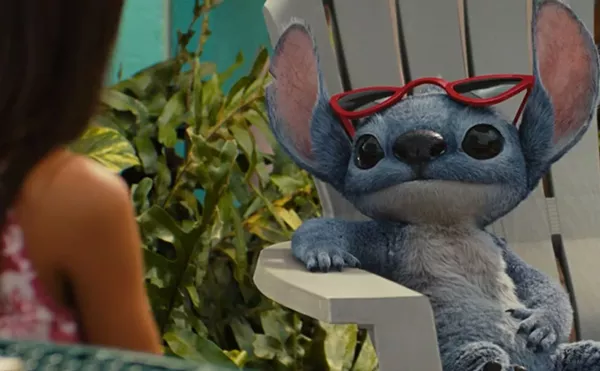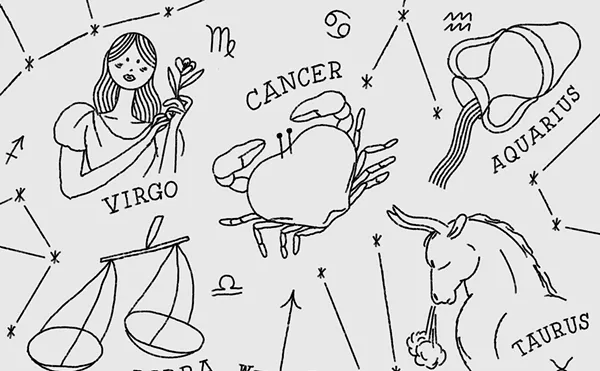
Audio By Carbonatix
[
{
"name": "GPT - Leaderboard - Inline - Content",
"component": "35519556",
"insertPoint": "5th",
"startingPoint": "3",
"requiredCountToDisplay": "3",
"maxInsertions": 100,
"adList": [
{
"adPreset": "LeaderboardInline"
}
]
}
]
The day of creation and destruction begins like a dream with some dialogue and meditation. I’m sitting on a wooden stoop in a yard that resembles a junked-up Eden, and there’s a frying pan at my feet. A giant rusted fish is staring at me with eyes the size of film reels, and a little white dog is begging me to pull on a soaked ball clenched between his tiny Tic-Tac teeth.
Out back at Zeitgeist Gallery, artists begin to arrive for an afternoon of collaboration, but I’ve shown up before the fun begins. There’s still some tidying of the chaos from last week’s barbecue, so I watch John Jakary attack the perimeter of a sandbox with a weed whacker while waiting for everyone. Soon, Maurice Greenia Jr. joins us, sweating from an hour-long bus ride, and others trail behind — Gary Freeman, Eric Mesko, Jim Puntigam, Troy Richard, Vito Valdez, Heather White and Bec Young.
For the past four years, a rotating group of a few dozen artists have dutifully met a few days a week to work together, often simultaneously, creating paintings and sculptures. “A jam session is a social process,” Mesko says. “As an artist, you create your own problems. But here you are also dealing with someone else’s problems that have already been set up. Sometimes, you find each other and it really flows.”
To get in the right mindset, Greenia says his friend and mentor, French artist and gallery owner Jacques Karamanoukian, thought it was a good idea to walk around museums and figure out which pieces still needed finishing.
Zeitgeist Gallery hosts an annual auction of collaborative works in hopes of raising funds to offset the cost of general operations. The event on Saturday, Aug. 13, features works by Gwen Joy, Tom Humes, Jack Johnson, Patrick Dodd, James Hart Jr., Vito Valdez, Eric Mesko, Maureen Maki, Maurice Greenia Jr. and more, all of it created in a style somewhere between outsider art and surrealism that Greenia calls “extreme expressionism.”
Today is especially busy because of the impending auction. Puntigam prepares for aluminum-poured sculptures by filling and covering a barrel with scrap metal and connecting it to a propane tank. With a whoosh, it lights. Meanwhile, inside the gallery’s theater space, Greenia has put on a Thelonious Monk album and joins Freeman, who has already found his spot, squatting in front of a chair serving as a makeshift easel, painting a cigar in the mouth of a snake.
Greenia takes a portrait by Patrick Dodd off the wall and puts it down on a small table, running his fingertips over the oils he will soon cover with his own colors. “I get a sense of the painting from its texture,” he says. “It helps me to figure out what’s going on with it.” A blank canvas is terrifying, but it can be more of a challenge to approach a piece that’s already worked on. Greenia has the nerve, but tries to be careful of going too far.
“One time, four or five of us had worked on a thing for hours, and someone came in and covered it entirely. You can be a bull in a china shop, and just paint over everything. That’s a valid approach, but I try to be more sensitive.”
The room is peaceful for some time, filled with the echoing rhythms of Balinese gamelan music, before Eric Mesko walks in. He sits down on a stool with a sketchbook. In ink, Mesko draws a cluster of skulls, and then glues on the farcical-looking heads of George W. Bush and Donald Rumsfeld, cut from Newsweek.
He notices me eyeing the page and breaks the silence with an announcement: “Incompetence, arrogance and self-righteousness. They have graphed us into a pit.” Mesko stops drawing to tell me that, centuries ago, when a Roman military general won a battle, the emperor threw a parade in his honor, and the general rode on a chariot. “But the emperor always made sure a man stood behind the general with his arm on his shoulder, repeating the words, ‘Remember — you are just a man.’ If I weren’t so sad I feel like crying, I’d be mad. Nobody does that for these guys anymore.”
As Mesko talks, Greenia pauses to listen and inevitably his mood shifts, as does his perspective about the piece he’s working on. Artistic collaboration doesn’t merely occur when artists work on the same page; it happens when they share studio space.
I wander out back, where Vito Valdez is making a wooden harness for Mary Herbeck’s torpedo rain stick, a spinning metal sculpture that serves as a metaphor for healing the earth and warning about violence. Herbeck and Valdez have worked on other art pieces together, so she’s given Valdez the freedom to make the harness as he wishes. Seemingly inspired by the calm of Herbeck’s work, Valdez talks about the Great Lakes as he paints in broad strokes of maroon and yellow.
Some time later, Mesko steps outside, ready to work on canvas with Valdez, asking his friend: “What if we each do one half at the same time? I’ll put a line, or maybe more of a squiggle, down the center, and we each work on a side.” Valdez agrees, and as he finishes painting the harness, Mesko brings out a piece of plywood, props it under a tree and begins priming it as he tells me about his friendship with Valdez. It’s clear the two of them are close, as even the conversation becomes collaboration.
“We lived together for two years,” Valdez says.
“We did a lot of work together then,” Mesko says.
“He’s usually the boss and I’m the assistant,” Valdez says, teasing.
On the left side of the board, Mesko outlines the shape of a figure, arms and legs akimbo, in yellow house paint. Valdez joins in, and the two of them work. Their artistic styles may be different, but the contrast between their painterly habits is more obvious. Mesko is chatting away as he rigorously works the surface with quick, sharp strokes, while Valdez is doing a dance — approaching the canvas, then taking a couple of steps back, coming toward it and backing up again. Mesko’s discussion is clearly a distraction. “I can’t paint when you are talking business,” Valdez says.
Only a few minutes pass before Mesko finishes his side — an electric scene in pink with splatters of orange and black — and he walks back inside, on to another project. Left alone for a while, Valdez completes what looks like the large visage of a woman, also making marks to unify the canvas, cautiously choosing where he places the brush. When Mesko returns, Valdez asks him if he’s OK with what he did. A generous spirit is not in the least surprising here at Zeitgeist, where art is a joining of philosophies, and friends nod in approval.
Meanwhile, Troy Richard is up on the ladder making a mosaic while listening to a recording of William Burroughs reading a story. On the opposite end of the yard, Puntigam, Jakary and White, wearing gas masks and several layers of clothing, are judiciously pouring molten aluminum from the kiln. The smell of the smoke from the melted metal is drugging, reminding me that I’ve spent four hours in the sun and my face feels like it’s burning. Somehow, I feel refreshed, like I just woke up.
“The Fourth Annual Visual Jam Sessions and Fund Raiser” is 7 p.m.-midnight on Saturday, Aug. 13, at Zeitgeist Gallery, 2661 Michigan Ave., Detroit; 313-965-9192.
Rebecca Mazzei is Metro Times arts editor. Send comments to rmazzei@metrotimes.com



